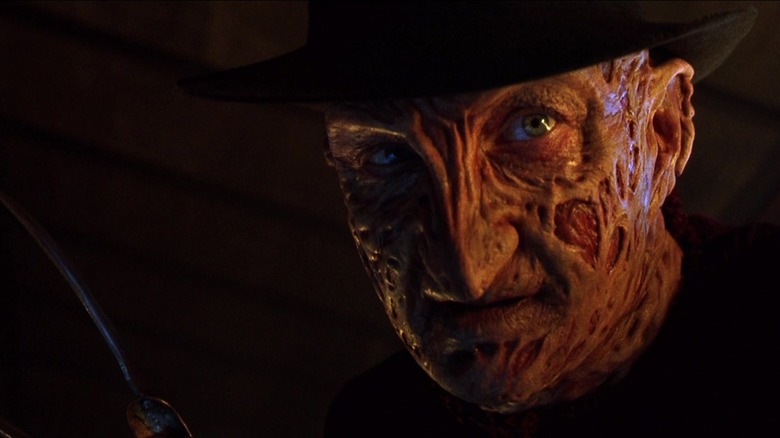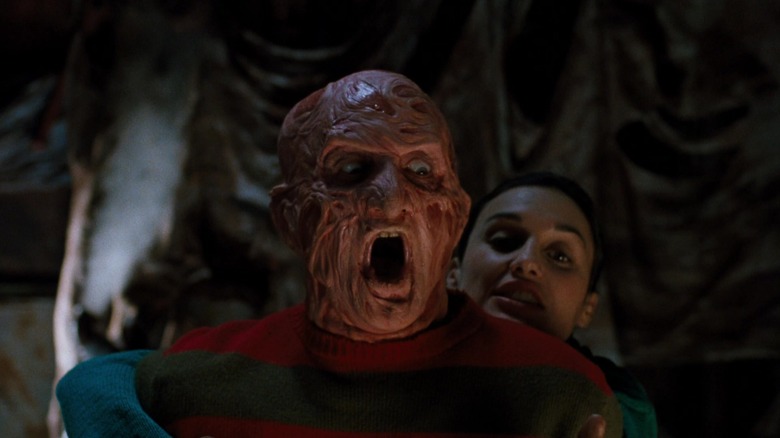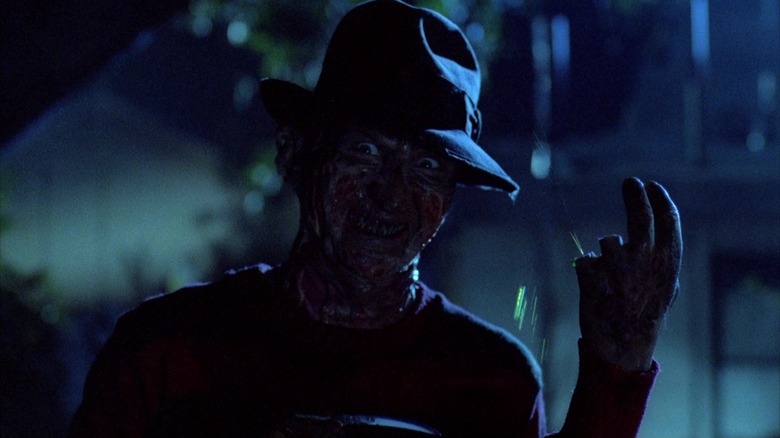The Nightmare On Elm Street Series Is Dead – But We Have One Wild Idea To Resurrect It
From 1984 to 1994, the "Nightmare on Elm Street" film series was rolling high. The premise was novel and captured the public's imagination: a child murderer named Freddy Krueger (Robert Englund) was killed in a fire by the angry parents of his many victims. Freddy's ghost, however, entered a subconscious dimension, allowing him to appear in people's dreams. Now charred from the fire, and wearing a bladed glove he wielded in life, Freddy took revenge on his murderers by killing their surviving children ... in their dreams. The teens of Springwood, Ohio would dream of Freddy, and he would happily torture and murder them in their subconscious. When they die in their dreams, they die in real life.
This premise lasted through seven feature films, each one more surreal than the last. The dreams became delightfully, horrifically weird, and special effects were imaginative and marvelous. Freddy was killed in Rachel Talalay's 1991 flick "Freddy's Dead: The Final Nightmare," but was resurrected (in novel fashion) by series originator Wes Craven for "Wes Craven's New Nightmare" in 1994. Englund returned for the goofy fan mashup "Freddy vs. Jason" in 2003, but that was more like a playful nostalgic victory lap for Freddy than a serious addition to the canon. By then, Englund was 56 and likely ready to put the role to bed. Apart from an abysmal "A Nightmare on Elm Street" remake in 2010, there have been no Freddy appearances in film since. The series has been dead for a while.
But there is a way to resurrect the series, and one that can keep the horror going. If Freddy can appear in people's dreams, he is unbeholden to time. What if he could appear in the dreams of famous horror authors?
Freddy's motives have changed to accomodate more sequels
Freddy, it should be noted, became unbound by motives sometime around Stephen Hopkins' 1989 entry, "A Nightmare on Elm Street 5: The Dream Child." Previously, Freddy had been making a pointed effort (mostly) to only stalk and kill the children's of his murderers (or their friends). It's a scary concept because the kids are unwittingly paying for the sin of their parents. Eventually, though, Freddy branched out, killing teenagers who were only tangentially connected to the children of his murderers. By the events of "Dream Child," Freddy essentially admitted that he merely enjoyed being a dream demon, and could feed on the souls of his victims. He became a freelance murderer.
With his motivations now open, Freddy was suddenly free to haunt the dreams of pretty much anyone he wanted. If you had heard of the legend of Freddy Krueger, you were a potential victim. He usually went after teens, but there was nothing stopping Freddy from haunting adults or the elderly.
This concept gives us a path forward on new "Nightmare on Elm Street" movies. There's no longer any need to pay attention to Nancy or the kids of Springwood. As Freddy himself once said, every town has an Elm Street. Freddy could now potentially appear anywhere in the nation, in anyone's dreams, and kill them for any reasons. He is no longer representative of the sins of the parents, but a free-floating anxiety demon. He now represents the very rot of America, the darkest parts of the human soul. After "Dream Child," he became a symbol for all personal fears. That makes him weirdly scarier.
And as long as that's true, let's take advantage of that. Let's put him anywhere. Or even ... anywhere in time.
In dreams, Freddy can travel through time
It hasn't been established that Freddy can travel through time, but as we all know from Christopher Nolan's film "Inception," time operates by different rules in the dream world. As such, there is no stopping Freddy from appearing in the dreams of people in the 19th century. And where would Freddy want to go? What minds would a horror demon feel most comfortable in? Why in the minds of horror authors, of course. Horror authors dream up monsters for a living, and constantly dwell on tales of the macabre.
Imagine a "Nightmare on Elm Street" movie wherein Edgar Allan Poe was drinking in the streets of Baltimore, passed out, and dreamed of Freddy. And then, what if there was a series of murders in Baltimore, and Poe was powerless to explain that they were being perpetrated by a man in his dreams? Freddy, we will learn, is responsible for "inspiring" Poe to write some of his grimmer tales.
And then keep going. It's 1816, and a young Mary Shelley is having a party with her husband Percy and the broody Lord Byron. They have a horror writing contest. Mary falls asleep and dreams of Freddy, tantalizing her with stories of fleshy resurrection. He kills several unnamed party-goers. The party lasts for days, and Mary can't explain. The only way she can "capture" Freddy is by turning him into a literary monster and throwing him on the page. This was the way Freddy operated in "New Nightmare," so there is very much precedent.
Let Freddy stalk historical horror authors. A dozen more movies can be made. Cast a good actor as Freddy, and let's get started.


